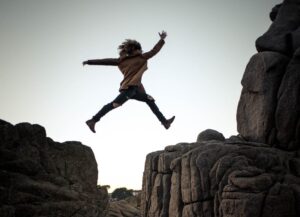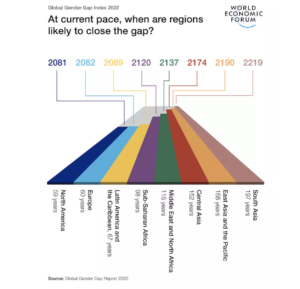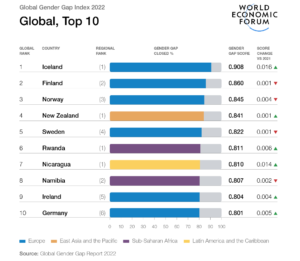
The 2022 World Economic Forum’s Gender Gap Report is out and Iceland is once again (for the 12th time to be precise) at the very top, and has closed more than 90% of its gender gap.
All the Nordics score, again, well. Finland, Norway and Sweden follow close behind. And only four countries out of the 146 in the list, are outside Europe: New Zealand (4th), Rwanda (6th), Nicaragua (7th) and Namibia (8th). The top five are unchanged from last year, but Lithuania and Switzerland have dropped out of the top 10, with Nicaragua and Germany taking their places.

The Global Gender Gap Index measure the world’s progress toward gender equality since 2006 considering contries’ acievement in four key dimension: Economic Participation and Opportunity, Education Attainment, Helath and Survival. As for today, it only 68,1% of the gender gap hase been closed. Converted in a time period, this menas that it will take 132 years globally to reach the gender equality – calculated by the different situations around the world, with the region of North America being generally more advanced, and South East Asia showing the bigger gap. It is a light improvement compared to last year, but not enought to bridge the huge step behind caused by the impact of Covid-19 on, well, everything and gender equality as well.

Countries with the least gender gap in 2022
1. Iceland
Iceland has almost entirely closed its gender gap in Educational Attainment, with a score of 0.993, where 1 means equality has been reached. While only 22% of the global gender gap in Political Empowerment has been closed, Iceland tops the entire Index in this dimension, due to having a higher share of women as head of state over the past 50 years and a higher share of women in parliament than other countries.
A fair sharing of unpaid work has been instrumental to Iceland’s progress, Joeli Brearley, author of The Motherhood Penalty, told the World Economic Forum: “When 90% of women went on strike over this in the 1970s, it showed men there is value in this work, they cannot do their jobs without it. That was the big shift for Iceland in terms of gender equality.”
2. Finland
Finland has achieved full parity in Educational Attainment and near parity (0.97) in the Health and Survival subindex. But its 2022 score in Economic Participation and Opportunity (0.789) is lower than for 2021 (0.806) due to a drop in parity for labour force participation, a fall in both men’s and women’s estimated earned income, and a decline in gender parity in wage equality.
3. Norway
At 0.845, Norway’s score is slightly lower than its highest achieved in 2021. Educational Attainment is Norway’s highest subindex score at near full parity (0.989). In Economic Participation and Opportunity, the country’s score of 0.765 marks a decrease of 3% from a year earlier, slipping to levels Norway registered back in 2007. This year’s numbers reflect lower levels of women participating in the workforce, and holding posts as legislators, senior officials and managers.
4. New Zealand
New Zealand has achieved parity across the board in the Education category. In Health and Survival, it has improved its ranking in healthy life expectancy. The level of parity the country reached this year in the Economic subindex is lower than last year, as the rate at which women participate in the workforce decreased, although wage equality for similar work increased. In the Political Empowerment subindex, New Zealand improved its score from last year by 0.03, as its share of female leadership at head-of-state level increased.
5. Sweden
Sweden has closed the gender gap on Educational Attainment and its second-highest score is in the Health and Survival subindex (0.963), where it holds on to the gains made in 2021. It comes first for Economic Participation and Opportunity in the region, with a high level of female workforce participation, parity in the participation of women in professional and technical roles, and a level of parity in estimated earned income higher than 137 other countries.
6. Rwanda
Rwanda has featured in the top 10 every year since it was first included in the Index in 2014 – and this year it has climbed one place in the rankings, as well as leading Sub-Saharan Africa. Its highest subindex scores are in Educational Attainment and Health and Survival (0.96 and 0.974, respectively). It has reduced the gender gap in tertiary education by 2.9% and maintained parity in compulsory education.
In Economic Participation and Opportunity, Rwanda is one of three economies that registered parity in labour force participation in 2022 (alongside Sierra Leone and Burundi). In Political Empowerment, the country also recorded parity at ministerial and parliamentary levels.
7. Nicaragua
Progress since 2021 sees Nicaragua move up five places in 2022 to 7th position. It has closed the gap in the Educational Attainment subindex, across all its indicators. In the Political Empowerment subindex, Nicaragua remained in 5th spot, with continued parity in ministerial positions from 2021. It has raised its score for parliamentary parity from 0.938 last year to 1.
But its gender gaps have widened in Economic Participation and Opportunity since 2017. This year, the gaps are evident in women’s labour force participation and in wage equality. However, Nicaragua has maintained 2021 levels of women’s participation in professional, technical roles, and as legislators, officials and senior managers. Equality on estimated earned income also increased, from 0.456 to 0.682.
8. Namibia
Namibia has dropped two places since last year. Its performance in the Health and Survival subindex has remained unchanged since 2014, but it reported lower levels of parity in three Economic Participation and Opportunity indicators than in 2021: women’s labour force participation (-0.014), wage equality (-0.017) and estimated earned income (-0.005).
Although it reported parity across all levels of education and a high literacy score (0.998), Namibia’s ranking in the Educational Attainment subindex has not gained ground since slipping from parity in 2016. In the Political Empowerment pillar, the only change in 2022 was a small reduction of the gender gap score for women in ministerial positions (-0.001).
9. Ireland
Ireland remains in 9th place, but it has recovered ground lost since posting its highest score in 2016 (0.806). It closed the gap in the Educational Attainment subindex, and its overall Economic Participation score rose by 0.013 thanks to continued parity in women’s participation as professional and technical workers, and by a reduction of gender gaps in estimated earned income, wage equality, and the participation of legislators, senior officials, and managers. But these improvements are countered by a drop of 0.026 in women’s labour force participation.
10. Germany
Germany’s 2022 score is its highest ever and it returns to the top 10 this year, having ranked between 10 and 14 since 2008. It ranks highest in Political Empowerment, which is also the subindex where it has the highest level of improvement. Its score of 0.55 is higher than 94% of countries in the Index. It maintains high levels of parity in Educational Attainment, but has lower scores across indicators in Economic Participation and Opportunity compared with 2021.
63. Italy
With a score of 0.720, substantially with no score change compared to last yera, Italy is 63rd. The conutry scores well in Education Attainment, reaching a score of 9.995. But scores poorly in Health and Survival (108th) and in Economic Participation and Opportunity, scoring 110th. In this subsegment, Italy with North Macedonia and Bosnia Herzegovina is at the bottom of the regional ranking. Moreover, when in comes to closing the gender gap in labour-force participation rate, while most of the continent has closed at least 80% of their gender gap in labour-force participation rate (22 out of 35 countries), Italy again is not doing enough. With Romania, North Macedonia and Bosnia Herzegovina, it has closed less than 70% in this indicator.
The only sub-index in which the bel paese scores very well, lies under the Education Attainment domain; at the subindex Enrolment in tertiary educationfor Italy reaches the in first position.
***
Alley Oop’s newsletter: every Friday morning Alley Oop arrives in your inbox with news and stories. To register click here.
If you like to write or contact the Alley Oop’s editorial team, the email adress is alleyoop@ilsole24ore.com